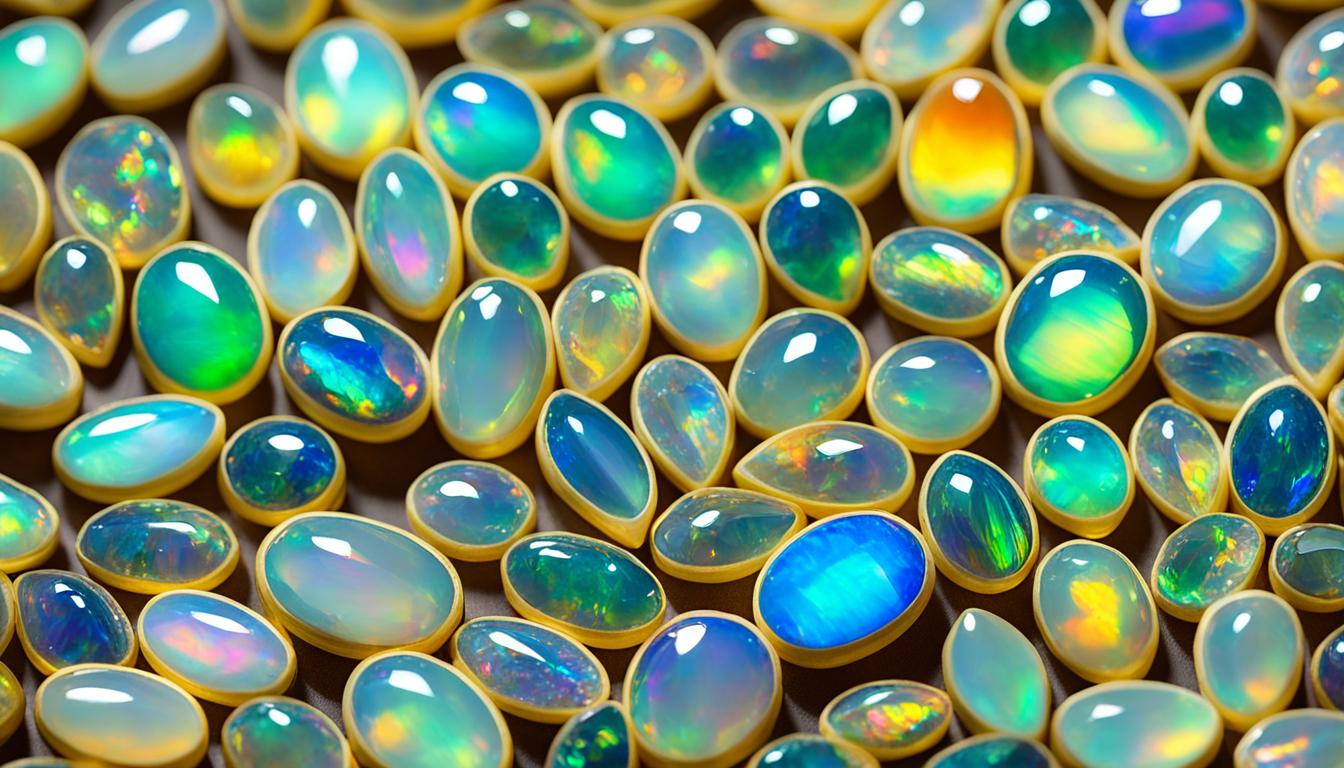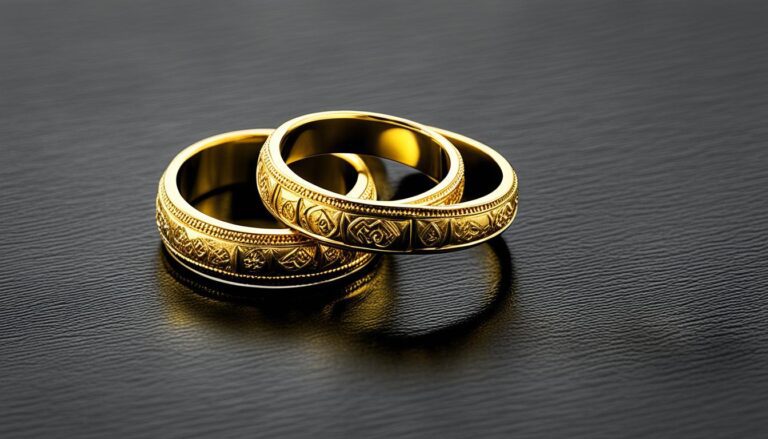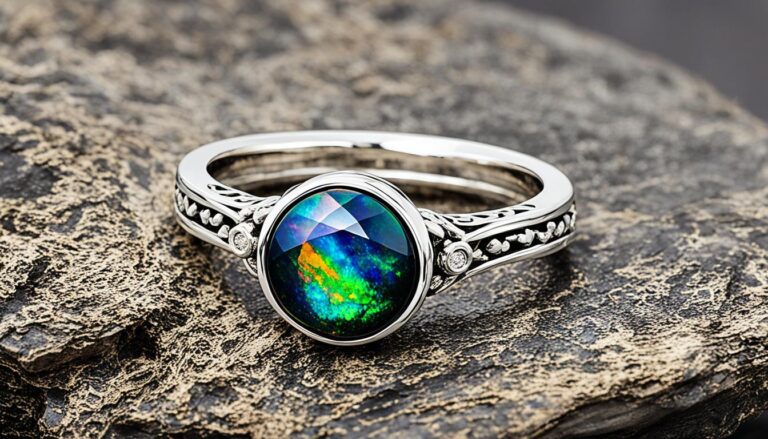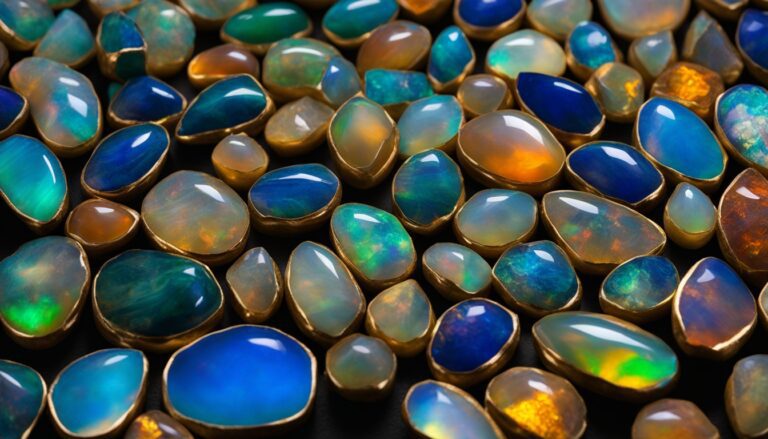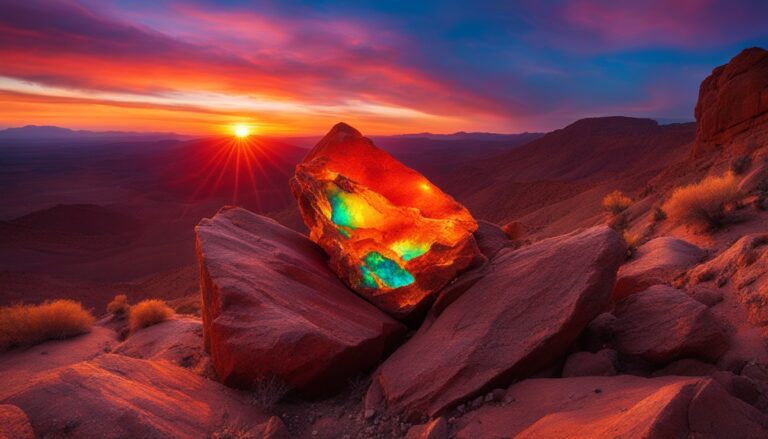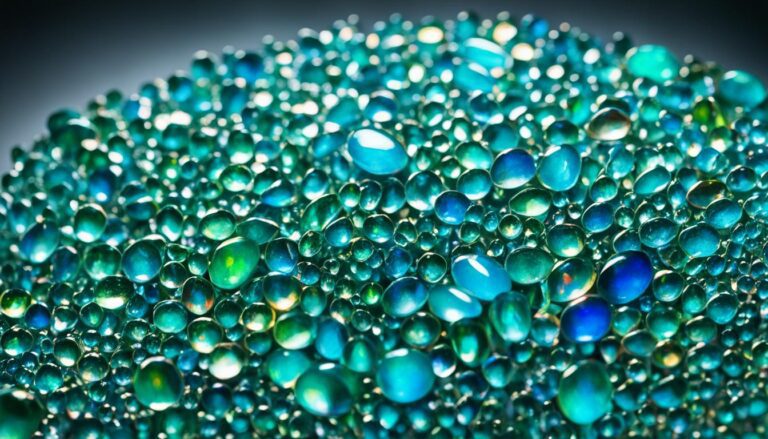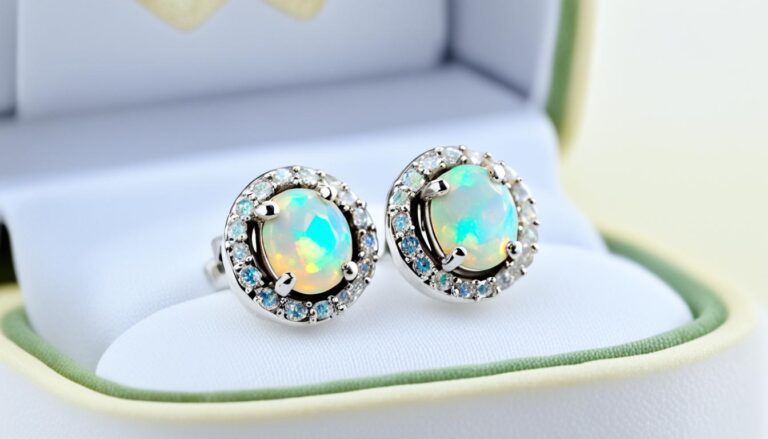Is Ethiopian Opal Real
Welcome to our article on Ethiopian opals! We’re here to talk about whether these gemstones are real. We’ll help you see what makes them special.
Ethiopian opals shine with many colors and are loved by gem fans around the globe. It’s important to know the real from the fake when buying them.
In 1994, these opals were found in Ethiopia. They’re real, natural gemstones made deep in the Earth. People value them for their one-of-a-kind look.
But how do you know if an opal is truly Ethiopian? We’ll share what to look for. The color play, base color, pattern, and any flaws are all important signs of a genuine opal.
If you’re interested in Ethiopian opals, keep reading. We’re here to give you tips on spotting the genuine ones. This info will help you buy with confidence.
What is a Natural Gemstone?
A natural gemstone is mined from the earth and cut into a sparkling gem. It’s a mineral or natural specimen. These gems form over millions of years with heat, pressure, and elements.
This makes natural gemstones a true work of nature. They are not created in labs. However, synthetic gemstones are human-made versions of natural ones.
What Are Synthetic Gemstones?
Synthetic gemstones are a new chapter in the jewelry story. They’re crafted in labs to copy the way real gems form naturally. These man-made gems look and act like natural ones.
Lab-grown diamonds show how these synthetic gems are becoming more popular. They are made to be just as dazzling as natural diamonds. But, they’re crafted in controlled settings and have the same materials as their real counterparts.
The Advantages of Synthetic Gemstones
Making synthetic gemstones doesn’t rely on nature’s slow processes. So, we can have more of them, and they cost less. This means more people can enjoy wearing gemstone jewelry without it being too expensive.
Choosing lab-grown gemstones also helps the planet and avoids unethical mining. When you pick synthetic gems, you’re choosing a greener option. This is because it doesn’t involve digging up the earth more.
The picture above shows a beautiful lab-grown gemstone. It proves that these synthetic gems can be just as gorgeous as natural ones.
And it’s not just diamonds that can be made this way. Cubic zirconia and moissanite are two other examples. They shine bright and are affordable, offering a great choice for jewelry lovers.
In conclusion, synthetic gemstones are human-made copies of real gems. They match the natural beauties in makeup and brilliance. So, whether it’s a lab-grown diamond or cubic zirconia, they stand for creativity and make stunning jewelry.
The Authenticity of Ethiopian Opal
Ethiopian opal is a natural gemstone formed in the Earth’s crust. It was first found in Ethiopia in 1994. This gem is known for its colorful appearance. It comes from volcanic rocks. These rocks are full of silica. The opals have a base color from white to brown. They also show vibrant flashes of different colors.
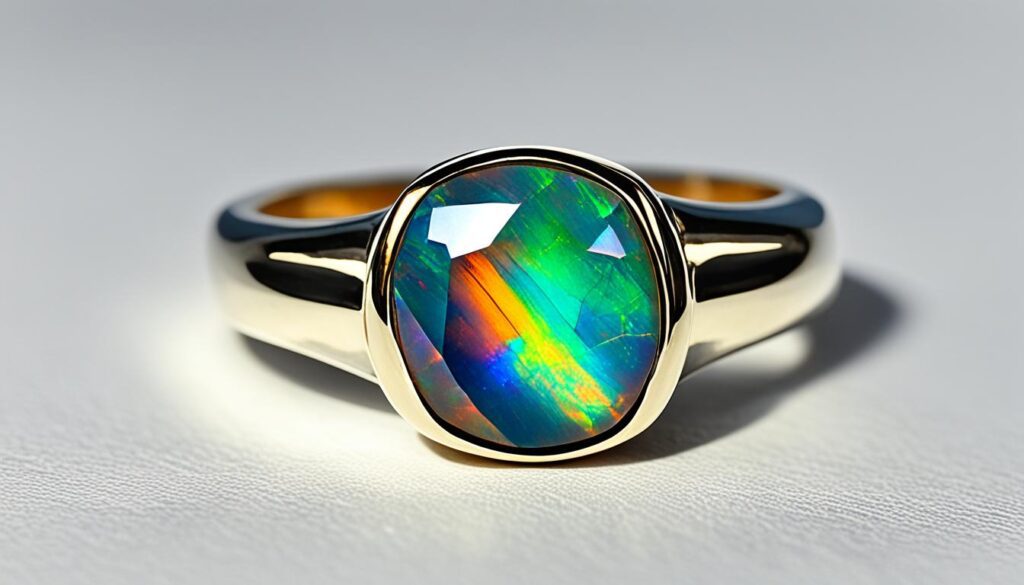
Ethiopian opals are not created by people. They are made by nature’s own processes. The Earth itself changes these rocks into gemstones. This makes each Ethiopian opal unique.
Some Ethiopian opals may undergo treatments. But don’t worry, they are still natural. These treatments only aim to highlight the opal’s beauty. They don’t take away from its natural origins.
This gemstone’s creation is truly amazing. It shows the incredible power of nature. The processes under the Earth’s surface result in these beautiful opals.
Distinguishing Real and Fake Ethiopian Opals
Differentiating real opals from fake ones is tricky. Some fakes look very similar to the real stones. However, some key signs help us spot the difference.
Real opals are famous for their play of color. They show bright colors that shine and shift as you move them. Fake opals, in contrast, may look dull or fake-like in color.
Look at the base color, too. Genuine opals usually start with a light base. This light base helps the colors on top to really pop. Fake opals often have a base color that doesn’t look natural.
How the color moves on the opal is a big clue. Real opals have lots of different color patterns, like big flashes or tiny pinpoints. These patterns make each opal unique. Fakes usually don’t show these detailed color patterns.
Real opals might have tiny marks or patterns on their surface. These small imperfections are actually signs of real opals. Fake opals, however, usually look too perfect and smooth.
The weight of the opal can also indicate its authenticity. Because real opals are denser, they are heavier for their size than fakes. A light opal might mean it’s not real.
Remember these tips when checking your opals. Always buy from trusted sellers. They can offer advice and guarantee your opal is real.
Buying Ethiopian Opals from Reputable Dealers
Buying Ethiopian opals is a big deal. Make sure you buy from trusted dealers who really know their stuff. At Opal Auctions, we’re proud to be a top source of these amazing opals. We always work hard to show we’re a reliable place to shop.
Our experts are all about being clear. We tell you upfront where the opals come from and how good they are. So, if you’re starting your collection or just buying your first opal, we’re here to help. We’ll answer all your questions to help you choose wisely.
It’s smart to check your opal with a pro. A certified appraiser or gemologist can give it a careful look. This step adds reassurance that you’re getting a top-notch Ethiopian opal. Believe us, this effort is so worth it.
Buying from trustworthy dealers and checking with experts can put your mind at ease. We ensure you get opals that are high-quality, ethical, and real.
Upholding Transparency at Opal Auctions
Opal Auctions values open and honest dealings in the opal trade. We make sure that every Ethiopian opal on our site is pure and top-notch. Trust is key when buying gems, and we aim for our clients to feel secure about what they get from us.
Our sellers follow strict rules to guarantee only real Ethiopian opals are on sale. We closely team up with them to give you precise details about each opal. This includes where it’s from and its grade. With us, you know you’re getting the finest, untouched opals.
Transparency and Information
Transparency is at the heart of what we do at Opal Auctions. We aim to give you all you need to choose wisely. Our opal listings feature clear info and top-notch photos. This lets you see and understand the beauty of each one.
Our open policy doesn’t stop at the product page. We urge you to ask us anything you need to know. Our team is here with expert advice to help you shop with confidence.
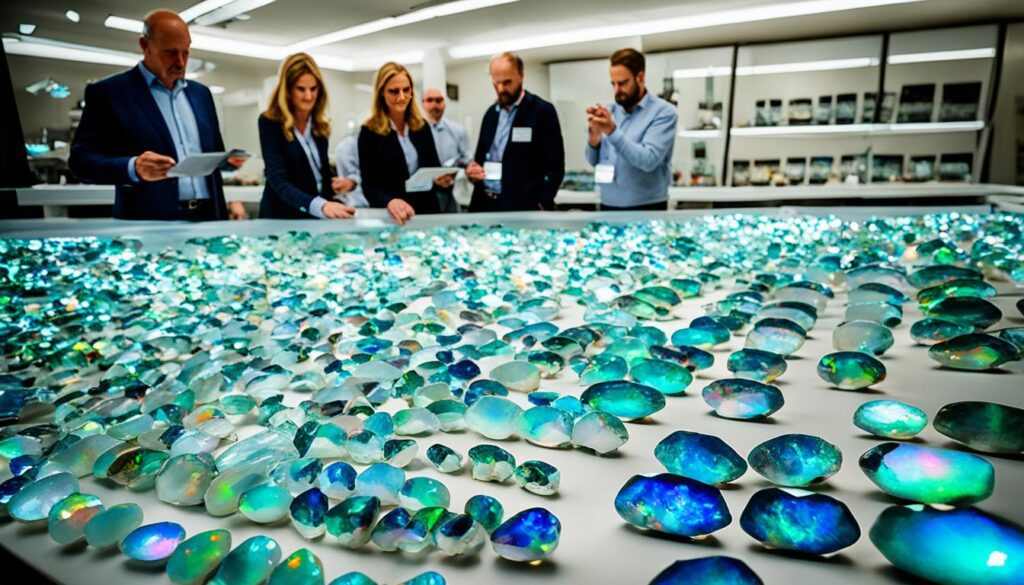
We hold transparency dear to build trust and offer great opals. First-timers and seasoned collectors alike trust Opal Auctions. We’re here to meet your desires with quality, natural Ethiopian opals.
The Value of Natural Gemstones
Natural gemstones stand out because of their special qualities. Things like bright colors, clear looks, and shine make them precious. A gemstone’s worth comes from how rare, high-quality, and wanted it is.
Gemstones that are hard to find become more valuable because they are rare. Quality matters a lot too. People really want gemstones that almost have no flaws. Also, if collectors and fans want a certain type, its price can go up.
To figure out a gemstone’s value, we look at these points carefully. Gems that are of top-notch quality, very rare, and popular cost more. This means they can be more expensive.
Appreciating Natural Gemstones
Buying natural gemstones is like getting a part of nature’s best work. Every gemstone shows Earth’s processes and has its unique beauty. From shining rubies to lovely sapphires, their value is eternal.
If you love jewels or collect them, owning natural gemstones lets you enjoy their rarity and charm. They keep their value well, so they are a great possession and a good investment.
The Beauty and Versatility of Opals
Opals are known for their beauty and many different colors. They’re a top pick for all sorts of jewelry. You can find them in earrings, necklaces, rings, and bracelets. Opals offer endless design options with their various colors, patterns, and shapes.
The most special thing about opals is how they shine with different colors. This happens when light hits their inside just right, showing off a spectrum of colors. It’s a beautiful sight that makes any piece of jewelry more captivating.
Opals aren’t just pretty; they also go well with any outfit. They come in different sizes and can be set in various ways. This means they can be unique centerpieces or add a special touch to other gems. Opals help make your jewelry more stylish, no matter your personal taste.
Opals come in a wide range of colors, from blues and greens to reds and oranges. Each one is unique, like a person’s fingerprint, with its own color mix and pattern. This makes opal jewelry truly one-of-a-kind and special.
Opals can be used in many types of jewelry, creating endless style options. You can find them in unique pendants, beautiful earrings, eye-catching rings, and elegant bracelets. This means opals are perfect for any look you want to achieve.
Opals stand out with their beauty and ability to fit any style. Their colors and uniqueness make for personal and stunning jewelry. Whether it’s for daily wear or a special event, adding opals to your collection brings joy and elegance.
Conclusion
In conclusion, Ethiopian opals are amazing natural gemstones. They come from deep in the Earth and dazzle us with color. Because of this beauty, people love to buy them.
Yes, there are fake opals out there, too. But, you can tell real Ethiopian opals from fake ones. Look closely at their color, the way colors move, and other details like how they feel and their weight.
Buying from trusted sellers is the best idea. Opal Auctions is one of these places. They know a lot about opals and can help you get a real, stunning Ethiopian opal. This way, you’ll have a special gem that lasts a lifetime.
Source Links
- https://www.opalauctions.com/learn/opal-information/ethiopian-opal-natural-how-to-spot-a-real-from-a-fake
- https://www.reddit.com/r/whatsthisrock/comments/10i5tdf/pretty_sure_i_know_the_answer_but_is_the_opal/
- https://medium.com/@thegemsheaven/is-ethiopian-opal-natural-how-to-spot-a-real-from-a-fake-724594ce045b

